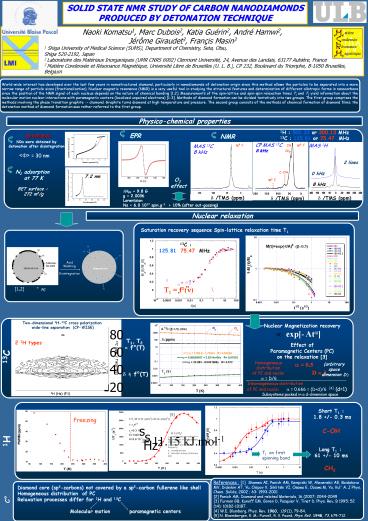Diapositive 1 - PowerPoint PPT Presentation
1 / 1
Title:
Diapositive 1
Description:
World-wide interest has developed over the last few years in nanostructured ... [5] N. Bloembergen, E. M.; Purcell, R. V. Pound, Phys. ReV. 1948, 73, 679-712. ... – PowerPoint PPT presentation
Number of Views:21
Avg rating:3.0/5.0
Title: Diapositive 1
1
SOLID STATE NMR STUDY OF CARBON NANODIAMONDS
PRODUCED BY DETONATION TECHNIQUE
Naoki Komatsu1, Marc Dubois2, Katia Guérin2,
André Hamwi2, Jérôme Giraudet3, Françis
Masin3 1 Shiga University of Medical Science
(SUMS), Department of Chemistry, Seta, Otsu,
Shiga 520-2192, Japan 2 Laboratoire des
Matériaux Inorganiques (UMR CNRS 6002) Clermont
Université, 24, Avenue des Landais, 63177
Aubière, France 3 Matière Condensée et
Résonance Magnétique, Université Libre de
Bruxelles (U. L. B.), CP 232, Boulevard du
Triomphe, B-1050 Bruxelles, Belgium
World-wide interest has developed over the last
few years in nanostructured diamond, particularly
in nanodiamonds of detonation origin since this
method allows the particles to be separated into
a more narrow range of particle sizes
(fractionalization). Nuclear magnetic resonance
(NMR) is a very useful tool in studying the
structural features and determination of
different allotropic forms in nanocarbons since
the position of the NMR signal of each nucleus
depends on the nature of chemical bonding 1,2.
Measurements of the spin-lattice and spin-spin
relaxation times T1 and T2 yield information
about the molecular motion nuclear interactions
with paramagnetic centers (localized unpaired
electrons) 1-3. Methods of diamond formation
can be divided tentatively into two groups. The
first group comprises the methods involving the
phase transition graphite ? diamond. Graphite
turns diamond at high temperature and pressure.
The second group consists of the methods of
chemical formation of diamond films the
detonation method of diamond formation was rather
referred to the first group.
Physico-chemical properties
Synthesis
1H 500.33 or 300.13 MHz 13C 125.81 or 75.47
MHz
EPR
NMR
NDs were obtained by detonation after
disintegration
CP MAS 13C 8 kHz
MAS 1H
MAS 13C 8 kHz
sp3 C
sp3 C
CH
ltFgt 30 nm
CH2
2 lines
N2 adsorption at 77 K BET surface 272 m2/g
C-OH
O2 effect
0 kHz
7.2 nm
sp2 C
8 kHz
DHPP 9.8 G g 2.0036 Lorentzian Ns 6.0 1017
spin.g-1 10 (after out-gassing)
d /TMS (ppm)
d /TMS (ppm)
d /TMS (ppm)
Nuclear relaxation
Saturation recovery sequence Spin-lattice
relaxation time T1
M(t) exp((-t/CT)b) CT relaxation coefficient
b 0.6 0.07
13C 125.81 75.47 MHz
H
H
H
H
H
Acid Washing Disintegration
Diamond core
OH
1,2
H
PC
Two-dimensional 1H-13C cross polarization
wide-line separation (CP-WISE)
Nuclear Magnetization recovery Effect of
Paramagnetic Centers (PC) on the relaxation 3
80
exp- Ata
T1, T2 f(T)
2 1H types
60
13C
a 0.5 D 3
13C (ppm / TMS) (F2)
Homogeneous distribution of PC and nuclei a
D/6
40
(arbitrary space dimension D )
20
Inhomogeneous distribution of PC and nuclei
a 0.666 (Dd)/6 4 (d1) Subsystems packed
in a d-dimension space
1H (Hz) (F1)
Short T1 1.8 /- 0.3 ms C-OH Long T1 61
/- 10 ms CH2
5
Freezing
1H
- H g2h02
- g magnetogyric constant of 1H
- h0 amplitude of the fluctuating magnetic field,
- nuclear spin resonance frequency
- t correlation time.
- E activation energy (Arrhenius law)
T1 on first spinning band
References 1 Shames AI, Panich AM, Kempiski
W, Alexenskii AE, Baidakova MV, Dideikin AT, Yu.
Osipov V, Siklitski VI, Osawa E, Ozawa M, Ya.
Vul' A. J Phys. Chem. Solids, 2002 63
1993-2001 2 Panich AM. Diamond and related
Materials, 16 (2007 20442049 3 Furman GB,
Kunoff EM, Goren D, Pasquier V, Tinet D. Phys.
Rev. B 1995 52 (14) 10182-10187. 4 W.E.
Blumberg, Phys. Rev. 1960, 119 (1), 79-84. 5 N.
Bloembergen, E. M. Purcell, R. V. Pound, Phys.
ReV. 1948, 73, 679-712.
Diamond core (sp3-carbons) not covered by a
sp2-carbon fullerene like shell Homogeneous
distribution of PC Relaxation processes differ
for 1H and 13C Molecular motion
paramagnetic centers
C































